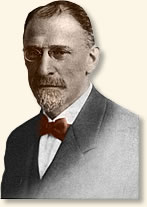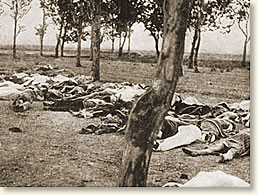|
The Massacre of the Armenians, 1915
The Armenian people trace their history back to the Bronze Age. At the height of its power in the first century BC, the Armenian kingdom controlled the territory between the Caspian Sea and the Mediterranean Sea in an area roughly equivalent to modern-day Turkey. Christianity spread into the region soon after the death of Christ with the establishment of numerous Christian communities. In 301, Armenia became the first state to proclaim Christianity its official religion.
 |
Ambassador Henry Morgentau
Click image to read a telegram
from Morgenthau to the State
Department |
By the beginning of the 20th century, Armenia's glory days were a distant
memory. They had been absorbed by the Ottoman Empire and occupied a reduced
territory located in what is now north-eastern Turkey. Still strongly Christian,
they enjoyed relative tolerance within the Muslim Ottoman Empire. However,
during the period between 1892 and 1894 The Armenians suffered a series of
massacres instigated by the reigning Sultan Abdul Hamid II in which between
80,000 and 300,000 lost their lives.
With the outbreak of World War I and the threat of Russian invasion, the Ottomans
began to suspect the loyalty of the Armenians and feared that they might actively
support the Russians if an invasion occurred. To prevent this, the Ottomans
devised a plan to eliminate the Armenians from their territory that resulted
in one of the bloodiest, systematic massacres of the 20th century.
The atrocities began in the spring of 1915 with the methodical killing of as many young, able-bodied Armenian men as possible. This was followed by the forced evacuation of thousands of Armenians from their homeland to the desert area in what today is Syria. Compelled to make the journey on foot and continually attacked throughout their trek, thousands died. It is estimated that between 600,000 and 1.5 million Armenians lost their lives during this period.
Much of what we know about this period of carnage comes to us through the writings of Henry Morgenthau, the American Ambassador to the Ottoman Empire from 1913 to 1916. The Ambassador supplemented his personal observations of the treatment of the Armenians with eyewitness reports from informants throughout the country.
Ambassador Morgenthau describes the forced evacuation of one group of Armenians from their homeland to the Syrian desert:
"All through the spring and summer of 1915 the deportations took place. . . Scarcely a single Armenian, whatever his education or wealth, or whatever the social class to which he belonged, was exempted from the order. In some villages placards were posted ordering the whole Armenian population to present itself in a public place at an appointed time-usually a day or two ahead, and in other places the town crier would go through the streets delivering the order vocally. In still others not the slightest warning was given.
The gendarmes would appear before an Armenian house and order all the inmates
to follow them. They would take women engaged in their domestic tasks without
giving them the chance to change their clothes. The police fell upon them just
as the eruption of Vesuvius fell upon Pompeii; women were taken from the washtubs,
children were snatched out of bed, the bread was left half baked in the oven,
the family meal was abandoned partly eaten, the children were taken from the
schoolroom, leaving their books open at the daily task, and the men were forced
to abandon their ploughs in the fields and their cattle on the mountain side.
Even women who had just given birth to children would be forced to leave their
beds and join the panic-stricken throng, their sleeping babies in their arms.
Such things as they hurriedly snatched up - a shawl, a blanket, perhaps a few
scraps of food - were all that they could take of their household belongings.
To their frantic questions 'Where are we going?' the gendarmes would vouchsafe
only one reply: 'To the interior.'
. . . 'Pray for us,' they would say as they left their homes - the homes in which their ancestors had lived for 2,500 years. 'We shall not see you in this world again, but sometime we shall meet. Pray for us!'
 |
Armenian victims gather
in the city of Van
Click image to learn of
American relief efforts
|
The Armenians had hardly left their native villages when the persecutions began. The roads over which they travelled were little more than donkey paths; and what had started a few hours before as an orderly procession soon became a dishevelled and scrambling mob. Women were separated from their children and husbands from their wives. The old people soon lost contact with their families and became exhausted and footsore. The Turkish drivers of the ox-carts, after extorting the last coin from their charges, would suddenly dump them and their belongings into the road, turn around, and return to the village for other victims.
Thus in a short time practically everybody, young and old, was compelled to travel on foot. The gendarmes whom the Government had sent, supposedly to protect the exiles, in a very few hours became their tormentors. They followed their charges with fixed bayonets, prodding any one who showed any tendency to slacken the pace. Those who attempted to stop for rest, or who fell exhausted on the road, were compelled, with the utmost brutality, to rejoin the moving throng. They even prodded pregnant women with bayonets; if one, as frequently happened, gave birth along the road, she was immediately forced to get up and rejoin the marchers. The whole course of the journey became a perpetual struggle with the Moslem inhabitants.
When the victims had travelled a few hours from their starting place, the Kurds would sweep down from their mountain homes. Rushing up to the young girls, they would lift their veils and carry the pretty ones off to the hills. They would steal such children as pleased their fancy and mercilessly rob all the rest of the throng. If the exiles had started with any money or food, their assailants would appropriate it, thus leaving them a hopeless prey to starvation. They would steal their clothing, and sometimes even leave both men and women in a state of complete nudity. All the time that they were committing these depradations the Kurds would freely massacre, and the screams of women and old men would add to the general horror.
And thus, as the exiles moved, they left behind them another caravan - that of dead and unburied bodies, of old men and of women dying in the last stages of typhus, dysentery, and cholera, of little children lying on their backs and setting up their last piteous wails for food and water. There were women who held up their babies to strangers, begging them to take them and save them from their tormentors, and failing this, they would throw them into wells or leave them behind bushes., that at least they might die undisturbed. Behind was left a small army of girls who had been sold as slaves - frequently for a medjidie, or about eighty cents - and who, after serving the brutal purposes of their purchasers, were forced to lead lives of prostitution.
 |
Armenian victims left by the roadside
|
A string of encampments, filled by the sick and the dying, mingled with the unburied or half-buried bodies of the dead, marked the course of the advancing throngs. Flocks of vultures followed them in the air, and ravenous dogs, fighting one another for the bodies of the dead, constantly pursued them. The most terrible scenes took place at the rivers, especially the Euphrates. Sometimes, when crossing this stream, the gendarmes would push the women into the water, shooting all who attempted to save themselves by swimming. Frequently the women themselves would save their honour by jumping into the river, their children in their arms.
. . . All the way to Ras-ul-Ain, the first station on the Bagdad line, the existence of these wretched travellers was one prolonged horror. The gendarmes went ahead, informing the half-savage tribes of the mountains that several thousand Armenian women and girls were approaching. The Arabs and Kurds began to carry off the girls, the mountaineers fell upon them repeatedly, violating and killing the women, and the gendarmes themselves joined in the orgy. One by one the few men who accompanied the convoy were killed. The women had succeeded in secreting money from their persecutors, keeping it in their mouths and hair; with this they would buy horses, only to have them repeatedly stolen by the Kurdish tribesmen. Finally the gendarmes, having robbed and beaten and violated and killed their charges for thirteen days, abandoned them altogether.
Two days afterward the Kurds went through the party and rounded up all the males who still remained alive. They found about 150, their ages varying from 15 to 90 years, and these, they promptly took away and butchered to the last man. But that same day another convoy from Sivas joined - his one from Harpoot, increasing the numbers of the whole caravan to 18,000 people.
. . . On the seventieth day a few creatures reached Aleppo. Out of the combined convoy of 18,000 souls just 150 women and children reached their destination. A few of the rest, the most attractive, were still living as captives of the Kurds and Turks; all the rest were dead.'"
References:
This eyewitness account appears in: Morgenthau, Henry, Ambassador
Morgenthau's Story (1918); Miller, William, The Ottoman Empire and its Successors 1801-1927 (1936).
How To Cite This Article:
"The Massacre of the Armenians, 1915 " EyeWitness to History, www.eyewitnesstohistory.com
(2008).
|






